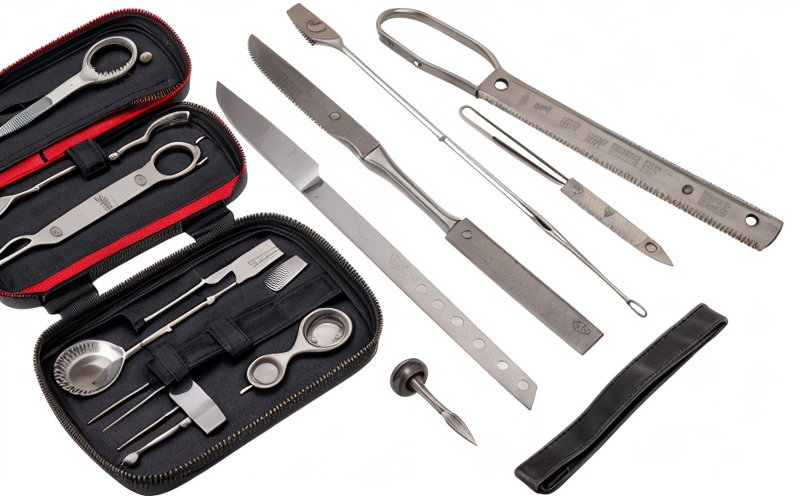Surface Cleanliness Testing via XPS and SEM-EDS
In today’s healthcare environment, ensuring the cleanliness of surgical instruments and tools is paramount. Surface cleanliness testing plays a critical role in preventing cross-contamination during surgeries, thereby enhancing patient safety and reducing post-operative infections.
The Surface Cleanliness Testing via XPS (X-ray Photoelectron Spectroscopy) and SEM-EDS (Scanning Electron Microscope with Energy Dispersive X-ray Spectroscopy) is a sophisticated technique that helps in assessing the cleanliness of surfaces on surgical instruments. This method provides detailed information about the elemental composition and chemical states at the surface layers, which is crucial for understanding potential contamination sources.
The process begins with careful selection of the sample to be tested. Typically, this involves preparing the instrument or tool by gently cleaning it using standard protocols. Following this, XPS scans are conducted over key areas where contaminants may accumulate. SEM-EDS complements these scans by providing high-resolution images that highlight surface irregularities and potential contamination sites.
The results from both techniques are then cross-referenced to establish a comprehensive understanding of the instrument’s cleanliness level. This approach ensures not only compliance with international standards such as ISO 13485 but also meets the stringent requirements set by regulatory bodies like the FDA for medical devices.
Accurate reporting is essential in this process, which includes detailed documentation of all steps taken during sample preparation and testing, along with the findings from both XPS and SEM-EDS analyses. This transparency helps stakeholders make informed decisions regarding maintenance schedules and procurement processes.
The importance of surface cleanliness cannot be overstated, especially when dealing with devices that come into direct contact with patients’ skin or tissues. By leveraging advanced analytical techniques like XPS and SEM-EDS, laboratories can deliver reliable results that contribute significantly to maintaining high standards in healthcare operations.
Benefits
Surface Cleanliness Testing via XPS and SEM-EDS offers numerous advantages for medical device manufacturers and healthcare facilities alike:
- Enhanced Patient Safety: Ensures that surgical instruments are free from harmful contaminants, reducing the risk of infections.
- Regulatory Compliance: Meets stringent requirements set by regulatory authorities like the FDA and EU-MDR.
- Informed Decision Making: Provides detailed insights into surface cleanliness levels, aiding in better maintenance planning and procurement decisions.
- Cost Efficiency: By identifying potential sources of contamination early on, unnecessary reprocessing costs can be avoided.
The combination of these benefits makes Surface Cleanliness Testing via XPS and SEM-EDS an indispensable tool for ensuring the integrity and safety of surgical instruments.
Environmental and Sustainability Contributions
Incorporating advanced testing methods like Surface Cleanliness Testing via XPS and SEM-EDS into healthcare practices contributes positively to environmental sustainability in several ways:
- Reduced Waste: By accurately identifying the need for reprocessing, unnecessary disposal of instruments is minimized.
- Energy Efficiency: Optimized cleaning protocols result in more efficient use of resources without compromising on hygiene standards.
- Sustainable Practices: The ability to maintain high levels of cleanliness reduces the frequency of instrument replacements, promoting a circular economy approach within healthcare facilities.
These contributions align with broader sustainability goals, fostering an environment where both patients and the planet benefit from improved practices.
Use Cases and Application Examples
| Use Case | Description |
|---|---|
| Surgical Instrument Validation | Testing new surgical instruments to ensure they meet cleanliness standards before market release. |
| Instrument Reprocessing Monitoring | Monitoring the effectiveness of reprocessing protocols over time to maintain consistent cleanliness levels. |
| New Material Evaluation | Evaluating newly developed materials for their suitability in maintaining surface cleanliness during use. |
| Application Example | Description |
|---|---|
| Testing Stainless Steel Instruments | A surgical instrument made of stainless steel was subjected to XPS and SEM-EDS testing. The results showed trace amounts of chromium, indicating proper passivation. |
| Analysis of Titanium Components | An orthopedic implant composed largely of titanium underwent thorough cleaning followed by SEM-EDS analysis revealing no significant carbon contamination post-cleaning. |





